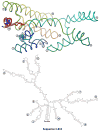In situ structures of the genome and genome-delivery apparatus in a single-stranded RNA virus
- PMID: 27992877
- PMCID: PMC5701785
- DOI: 10.1038/nature20589
In situ structures of the genome and genome-delivery apparatus in a single-stranded RNA virus
Abstract
Packaging of the genome into a protein capsid and its subsequent delivery into a host cell are two fundamental processes in the life cycle of a virus. Unlike double-stranded DNA viruses, which pump their genome into a preformed capsid, single-stranded RNA (ssRNA) viruses, such as bacteriophage MS2, co-assemble their capsid with the genome; however, the structural basis of this co-assembly is poorly understood. MS2 infects Escherichia coli via the host 'sex pilus' (F-pilus); it was the first fully sequenced organism and is a model system for studies of translational gene regulation, RNA-protein interactions, and RNA virus assembly. Its positive-sense ssRNA genome of 3,569 bases is enclosed in a capsid with one maturation protein monomer and 89 coat protein dimers arranged in a T = 3 icosahedral lattice. The maturation protein is responsible for attaching the virus to an F-pilus and delivering the viral genome into the host during infection, but how the genome is organized and delivered is not known. Here we describe the MS2 structure at 3.6 Å resolution, determined by electron-counting cryo-electron microscopy (cryoEM) and asymmetric reconstruction. We traced approximately 80% of the backbone of the viral genome, built atomic models for 16 RNA stem-loops, and identified three conserved motifs of RNA-coat protein interactions among 15 of these stem-loops with diverse sequences. The stem-loop at the 3' end of the genome interacts extensively with the maturation protein, which, with just a six-helix bundle and a six-stranded β-sheet, forms a genome-delivery apparatus and joins 89 coat protein dimers to form a capsid. This atomic description of genome-capsid interactions in a spherical ssRNA virus provides insight into genome delivery via the host sex pilus and mechanisms underlying ssRNA-capsid co-assembly, and inspires speculation about the links between nucleoprotein complexes and the origins of viruses.
Conflict of interest statement
The authors declare no competing financial interests.
Figures














Similar articles
-
Asymmetric cryo-EM reconstruction of phage MS2 reveals genome structure in situ.Nat Commun. 2016 Aug 26;7:12524. doi: 10.1038/ncomms12524. Nat Commun. 2016. PMID: 27561669 Free PMC article.
-
The asymmetric structure of an icosahedral virus bound to its receptor suggests a mechanism for genome release.Structure. 2013 Jul 2;21(7):1225-34. doi: 10.1016/j.str.2013.05.012. Structure. 2013. PMID: 23810697 Free PMC article.
-
Bacteriophage MS2 displays unreported capsid variability assembling T = 4 and mixed capsids.Mol Microbiol. 2020 Jan;113(1):143-152. doi: 10.1111/mmi.14406. Epub 2019 Nov 5. Mol Microbiol. 2020. PMID: 31618483 Free PMC article.
-
Simple rules for efficient assembly predict the layout of a packaged viral RNA.J Mol Biol. 2011 May 6;408(3):399-407. doi: 10.1016/j.jmb.2011.02.039. Epub 2011 Feb 25. J Mol Biol. 2011. PMID: 21354423 Review.
-
Cryo-EM reveals infection steps of single-stranded RNA bacteriophages.Prog Biophys Mol Biol. 2021 Mar;160:79-86. doi: 10.1016/j.pbiomolbio.2020.07.011. Epub 2020 Aug 22. Prog Biophys Mol Biol. 2021. PMID: 32841651 Review.
Cited by
-
Structural and dynamic asymmetry in icosahedrally symmetric virus capsids.Curr Opin Virol. 2020 Dec;45:8-16. doi: 10.1016/j.coviro.2020.06.002. Epub 2020 Jun 29. Curr Opin Virol. 2020. PMID: 32615360 Free PMC article. Review.
-
Visualizing a viral genome with contrast variation small angle X-ray scattering.J Biol Chem. 2020 Nov 20;295(47):15923-15932. doi: 10.1074/jbc.RA120.013961. Epub 2020 Sep 10. J Biol Chem. 2020. PMID: 32913117 Free PMC article.
-
Single-gene lysis in the metagenomic era.Curr Opin Microbiol. 2020 Aug;56:109-117. doi: 10.1016/j.mib.2020.09.015. Epub 2020 Oct 16. Curr Opin Microbiol. 2020. PMID: 33075663 Free PMC article. Review.
-
Expansion of known ssRNA phage genomes: From tens to over a thousand.Sci Adv. 2020 Feb 7;6(6):eaay5981. doi: 10.1126/sciadv.aay5981. eCollection 2020 Feb. Sci Adv. 2020. PMID: 32083183 Free PMC article.
-
All-atom molecular dynamics of the HBV capsid reveals insights into biological function and cryo-EM resolution limits.Elife. 2018 Apr 27;7:e32478. doi: 10.7554/eLife.32478. Elife. 2018. PMID: 29708495 Free PMC article.
References
-
- Lander GC, et al. The structure of an infectious P22 virion shows the signal for headful DNA packaging. Science. 2006;312:1791–1795. - PubMed
-
- Catalano CE. Viral Genome Packaging Machines: Genetics, Structure, and Mechanism. Springer; US: 2005.
References in Methods
-
- Suloway C, et al. Automated molecular microscopy: the new Leginon system. Journal of structural biology. 2005;151:41–60. - PubMed
-
- Mindell JA, Grigorieff N. Accurate determination of local defocus and specimen tilt in electron microscopy. Journal of structural biology. 2003;142:334–347. - PubMed
-
- Kivioja T, Ravantti J, Verkhovsky A, Ukkonen E, Bamford D. Local average intensity-based method for identifying spherical particles in electron micrographs. Journal of structural biology. 2000;131:126–134. - PubMed
-
- Ludtke SJ, Baldwin PR, Chiu W. EMAN: semiautomated software for high-resolution single-particle reconstructions. Journal of structural biology. 1999;128:82–97. - PubMed
Publication types
MeSH terms
Substances
Grants and funding
- DE023591/NH/NIH HHS/United States
- 1U24GM116792/NH/NIH HHS/United States
- R01 AI094386/AI/NIAID NIH HHS/United States
- CA177322/NH/NIH HHS/United States
- S10 OD018111/OD/NIH HHS/United States
- U24 GM116792/GM/NIGMS NIH HHS/United States
- R01 GM071940/GM/NIGMS NIH HHS/United States
- R01 DE023591/DE/NIDCR NIH HHS/United States
- DE025567/NH/NIH HHS/United States
- R01 DE025567/DE/NIDCR NIH HHS/United States
- GM071940/NH/NIH HHS/United States
- S10 RR023057/RR/NCRR NIH HHS/United States
- 1S10OD018111/NH/NIH HHS/United States
- AI094386/NH/NIH HHS/United States
- P01 CA177322/CA/NCI NIH HHS/United States
LinkOut - more resources
Full Text Sources
Other Literature Sources

